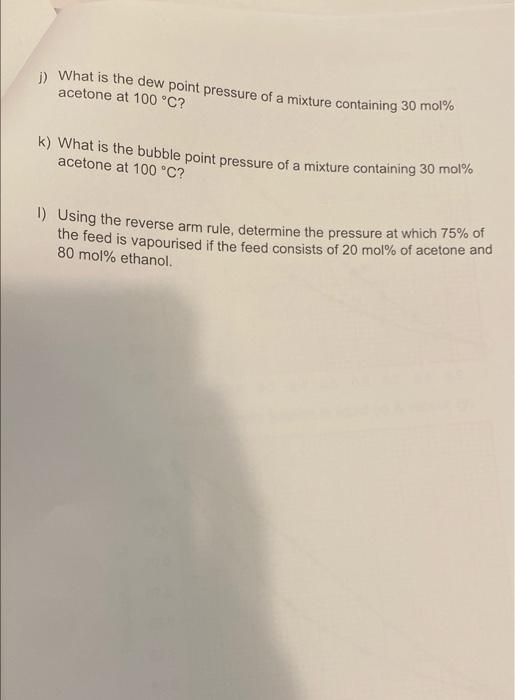Answered step by step
Verified Expert Solution
Question
1 Approved Answer
number the answrs please Question 2 Answer the following questions using the Pxy plot of acetone-ethanol system drawn given on the pages 7-8 and explain
number the answrs please 

Question 2 Answer the following questions using the Pxy plot of acetone-ethanol system drawn given on the pages 7-8 and explain your answer a) Identity and state the region on the Pay plot that comists of only liquid phase, vapour phase and the two-phase liquid-vapour mixture (if any) b) Identify and state on the Poxuy plot the bubbla tine and the dew line. c) What phase/phases are present if a mixture containing 50 mol% acetone at 2.8 atm is heated to 100C? d) What phase/phases are present it a mixture containing 50 mol% acetone at 3.2 atm is heated to 100C? e) What phase/phases are present if a mixture containing 50 mol% acetone at 3.6 atm is heated to 100C? What are the equilibrium compositions of any phases present at 20 mol% acetone, 100*C and 2.6 atm? g) What are the equilibrium compositions of any phases present at 20 mol% acetone, 100C and 2.4 atm? h) What are the equilibrium compositions of any phases present at 50 mol% acetone, 100C and 3.2 atm? 1) If you were plotting y-(ie. y vs. x) curve from this equilibrium data, what y value would you plot for x = 0.12 Page 3 of 8 1) What is the dew point pressure of a mixture containing 30 mol% acetone at 100C? k) What is the bubble point pressure of a mixture containing 30 mol% acetone at 100 C? 1) Using the reverse arm rule, determine the pressure at which 75% of the feed is vapourised if the feed consists of 20 mol% of acetone and 80 mol% ethanol 

Step by Step Solution
There are 3 Steps involved in it
Step: 1

Get Instant Access to Expert-Tailored Solutions
See step-by-step solutions with expert insights and AI powered tools for academic success
Step: 2

Step: 3

Ace Your Homework with AI
Get the answers you need in no time with our AI-driven, step-by-step assistance
Get Started


